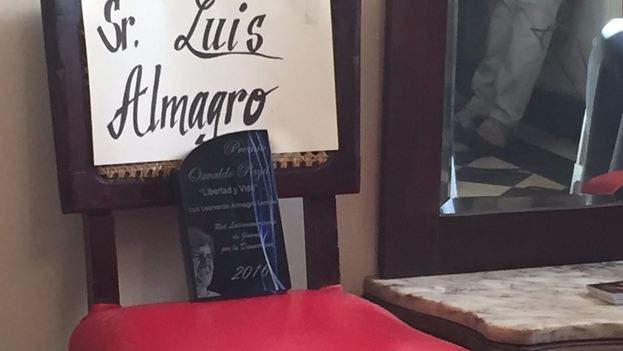
![]() 14ymedio, Pedro Campos, Miami, 23 February 2017 — The recent “diplomatic” action by the Cuban Government to try to prevent the presence of foreign personalities in a private event in Havana to receive a symbolic prize bearing the name of the late regime opponent Oswaldo Payá, denotes the weakness, fear and incapacity that characterize its actions since the visit of Barack Obama to Cuba and the subsequent death of Fidel Castro.
14ymedio, Pedro Campos, Miami, 23 February 2017 — The recent “diplomatic” action by the Cuban Government to try to prevent the presence of foreign personalities in a private event in Havana to receive a symbolic prize bearing the name of the late regime opponent Oswaldo Payá, denotes the weakness, fear and incapacity that characterize its actions since the visit of Barack Obama to Cuba and the subsequent death of Fidel Castro.
According to the declaration of the Ministry of Foreign Affairs (MINREX) in the newspaper Granma, the plan was to mount an open and serious provocation against the Cuban government in Havana, generate internal instability, damage the international image of the country and, at the same time, affect the good progress of Cuba’s diplomatic relations with other states.
According to MINREX, Almagro himself and some other right-wing individuals had the connivance and support of other organizations with thick anti-Cuban credentials, such as the Democracy and Community Center, the Center for the Opening and Development of Latin America (CADAL), the Inter-American Institute for Democracy, and a person they call a CIA terrorist and agent, Carlos Alberto Montaner.
In addition, says MINREX, since 2015 there has been a link between these groups and the National Foundation for Democracy in the United States (NED), which receives funding from the US government to implement its subversive programs against Cuba.
The dictatorship of the proletariat, which prevailed in Cuba 57 years ago, has thus invented an “anti-Cuban” (against Cuba or against themselves?), “imperialist”, “counterrevolutionary” and “CIA” hoax behind what could have been a small and simple limited ceremony; in short, if they had been allowed to hold it without the presence of foreign guests it would have served the Government to improve its image with respect to the rights of Cubans as citizens and shown some tolerance.
If they were a little bit capable they could have “stolen the show,” but we already know that in Cuba ‘counterintelligence’ dominates in its broadest sense.
Their response to this assessment is given by the MINREX note: “Perhaps some misjudged and thought that Cuba would sacrifice its essence to appearances,” as if appearances are not an example of essence. It is the ignorance of the dialectic relationship between form and content.
But in short, not one step back. According to MINREX the military state is in danger from this provocation, without arms, without masses, without leaders who enjoy wide support among Cubans on the island. We cannot give ground to the “counterrevolution,” — they say — as if it were not precisely the defenders of the indefensible regime themselves who prevented the revolutionary changes that would lead us to prosperous, democratic Cuba, free of authoritarian hegemonies, with all and for the good of all.
It is weakness, fear and incapacity that led the government to put its repressive character on full display and to miss the opportunity to have been hospitable to the Secretary General of the Organization of American States and to have discussed with him the conditions for possible ties to that Inter-American body.
If they were a little bit capable they could have “stolen the show,” but we already know that in Cuba ‘counterintelligence’ dominates in its broadest sense.
The organizations and individuals who prepared the event have a vision different from the government’s on the ways in which politics and the economy should be conducted in Cuba and, of course, it was an opportune moment to promote the positions of change previously promoted by the Leader of the Christian Liberation Movement, Oswaldo Payá, who died in circumstances demanding further explanation.
The actions of the Cuban government favored what the organizers of the event ultimately wanted to demonstrate: the absence of space in Cuba for different thinking
But if something like this can destabilize the regime, it should do the same!
The government’s actions provoked exactly what it was trying to avoid, creating more interest among Cubans and international opinion in the Varela Project and in how Oswaldo Paya died, a man who might not have been to the liking of the government and other cities, but who lived on the island, worked there and from from within promoted a peaceful and democratic change of the system, with all his rights as a Cuban citizen. Something to respect.
The Cuban government’s action, vitiated by extremism, Manichaeism, intolerance and repression, favored what the organizers of the event ultimately wanted to demonstrate: the absence of space in Cuba for different thinking, the existence of a tyrannical regime that impedes freedom of expression and association, and that it intends to continue to govern based on jails, police and repressive security agents.
The repression of the opposition, socialist dissent and different thinking, pressures against the self-employed, the stagnation of the reforms proposed by the Congress of the Communist Party of Cuba itself, the voluntary efforts to try to control the widespread corruption generated by statist wage system, in short, everything that is being done by the senior bureaucratic hierarchy is generating chaos that undermines and will burst the system from within from ignorance of the laws of economic-social development.
They don’t know where they stand! Don’t try to put the blame on others later.
This service against a “socialism” that has never existed will perhaps be the best historical legacy left to us by these 60 years of voluntarism, populism and authoritarianism of Fidel Castro communism, such that the most retrograde forces of international reaction will eternally thank the “Cuban leadership.”
